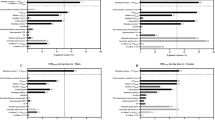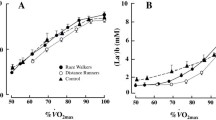Summary
To assess the most important determinant for successful distance running (800 m, 1500 m and 3000 m events) in female athletes, measurements of several anaerobic indices were made (peak power, mean power) using the Wingate anaerobic test (WAnT), and aerobic indices such as oxygen uptake \((\dot V_{O_{_2 } } )\) or running velocity (v) at lactate threshold (LT), \(\dot V_{O_2 }\), or v at onset of blood lactate accumulation (OBLA), running economy (RE), and maximal oxygen uptake were determined using the incremental treadmill test. The RE was represented by a \(\dot V_{O_2 }\) value measured at 240 m · min−1 of a standard treadmill velocity. A stepwise multiple regression analysis (SAS stepwise procedure) combined the best features of forward inclusion and backward elimination to determine the most important factors in predicting the performance of running these distances as dependent variables. The stepwise procedure showed that the blood lactate variables such as LT and/or OBLA are highly correlated with, and contributed to predicting performance running 800 m-3000 m, whereas the anaerobic component was related only to running 800 m. In conclusion, blood lactate variables account for a large part of the variation in distance running performance in female as in male runners. The component of the anaerobic system which can be measured by the WAnT was shown to contribute to performance in running 800 m, but not in longer distances.
Similar content being viewed by others
References
Allen WK, Seals DR, Hurley B, Ehsani AA, Hagberg JM (1985) Lactate threshold and distance running performance in young and old endurance athletes. J Appl Physiol 58:1281–1284
Bar-Or O (1987) The Wingate anaerobic test. An update on methodology, reliability and validity. Sports Med 4:381–394
Beaver WL, Wasserman K, Whipp BJ (1986) Improved detection of the lactate threshold during exercise using a log-log transformation. J Appl Physiol 59:1936–1940
Bulbulian R, Wilcox AR, Darabos BL (1986) Anaerobic contribution to distance running performance of trained cross-country athletes. Med Sci Sports Exerc 18:107–113
Conley DL, Krahenbuhl GS, Burkett LM, Miller AL (1981) Physiological correlates of female road racing performance. Res Q Exerc Sport 52:441–448
Costill DL, Daniels J, Evans W, Fink WJ, Krahenbuhl G, Saltin B (1976a) Skeletal muscle enzymes and fiber composition in male and female track athletes. J Appl Physiol 40:149–154
Costill DL, Fink WJ, Pollock ML (1976b) Muscle fiber composition and enzyme activities of elite distance runners. Med Sci Sports 8:96–100
Costill DL, Fink WJ, Flynn M, Kirwan J (1987) Muscle fiber composition and enzyme activities in elite female distance runners. Int J Sports Med [Suppl] 8:103–106
Daniels J, Krahenbuhl G, Foster C, Gilbert J, Daniels S (1977) Aerobic responses of female distance runners to submaximal and maximal exercise. Ann NY Acad Sci 301:726–733
Daniels J Scardina N, Hayes J Foley P (1986) Elite and subelite female middle- and long-distance runners. In: Landers DM (ed) Sport and elite performers. Human Kinetics, Illinois, pp 57–72
Farrell PA, Wilmore JH, Coyle EF, Billing JE, Costill DL (1979) Plasma lactate accumulation and distance running. Med Sci Sports Exerc 11:338–344
Favier R, Constable SH, Chen M, Holloszy JO (1986) Endurance training reduces lactate production. J Appl Physiol 61:885–889
Graves JE, Pollock ML, Sparling PB (1987) Body composition of elite female distance runners. Int J Sports Med [Suppl] 8:96–102
Holloszy JO, Rennie MJ, Hickson RC, Conlee RK, Hagberg JM (1977) Physiological consequences of the biochemical adaptations to endurance exercise. Ann NY Acad Sci 301:440–450
Hurley BE, Hagberg JM, Allen WK, Seals DR, Young JC, Cuddihee RW, Holloszy JO (1984) Effect of training on blood lactate levels during submaximal exercise. J Appl Physiol Respir Environ Exerc Physiol 56:1260–1264
Jacobs I (1986) Blood lactate: implications for training and sports performance. Sports Med 3:10–25
Karlsson J, Holmgren A, Linnarson D, Astrom H (1984) OBLA exercise stress testing in health and disease. In: Lollgan L, Mellerowicz H (eds) Progress in ergometry: quality control and test criteria. Springer, Berlin Heidelberg New York Tokyo, pp 67–91
Kumagai S, Tanaka K, Matsuura Y, Matsuzaka A, Hirakoba K, Asano K (1983) Relationships of anaerobic threshold and the onset of blood lactate accumulation with endurance performance. Eur J Appl Physiol 52:51–56
Pate RR, Sparling PB, Wilson GE, Cureton KJ, Miller BJ (1987) Cardiorespiratory and metabolic responses to submaximal and maximal exercise in elite women distance runners. Int J Sports Med [Suppl] 8:91–95
Powers SK, Dodd S, Deason R, Byrd R, McKnight T (1983) Ventilatory threshold, running economy and distance running performance of trained athletes. Res Q Exerc Sport 54:179–182
Stanley LJ, Brubaker CE (1973) Biomechanical and neuromuscular aspects of running. In: Wilmore JH (ed) Exercise and sports science reviews, vol 1. Academic Press, New York, pp 189–216
Tanaka K, Matsuura Y (1984) Marathon performance, anaerobic threshold, and onset of blood lactate accumulation. J Appl Physiol Respir Environ Exerc Physiol 57:640–643
Tanaka K, Matsuura Y, Matsuzaka A, Hirakoba K, Kumagai S, Sun-O S, Asano K (1984) A longitudinal assessment of anaerobic threshold and distance running performance. Med Sci. Sports Exerc 16:278–282
Tanaka K, Nakazawa T, Hazama T, Matsuura Y, Asano K (1985) A prediction equation for indirect assessment of anaerobic threshold in male distance runners. Eur J Appl Physiol 54:386–390
Williams C, Nute ML (1983) Some physiological demands of a half-marathon race on recreational runners. Br J Sports Med 17:152–161
Yoshida T (1986) Relationship of lactate threshold and onset of blood lactate accumulation as determinants of endurance ability in untrained females. Ann Physiol Anthropol 5:205–209
Yoshida T, Chida M, Ichioka M, Suda Y (1987) Blood lactate parameters related to aerobic capacity and endurance performance. Eur J Appl Physiol 56:7–11
Yoshida T, Udo M, Iwai K, Muraoka I, Tamaki K, Yamaguchi T, Chida M (1989a) Physiological determinants of race walking performance on female race walkers. Br J Sports Med 23:250–254
Yoshida T, Udo M, Chida M, Ichioka M, Makiguchi M (1989b) Dietary iron supplement during severe physical training in competitive female distance runners. Sports Tr Med Rehabil 1:(in press)
Author information
Authors and Affiliations
Rights and permissions
About this article
Cite this article
Yoshida, T., Udo, M., Iwai, K. et al. Significance of the contribution of aerobic and anaerobic components to several distance running performances in female athletes. Eur J Appl Physiol 60, 249–253 (1990). https://doi.org/10.1007/BF00379391
Accepted:
Issue Date:
DOI: https://doi.org/10.1007/BF00379391




